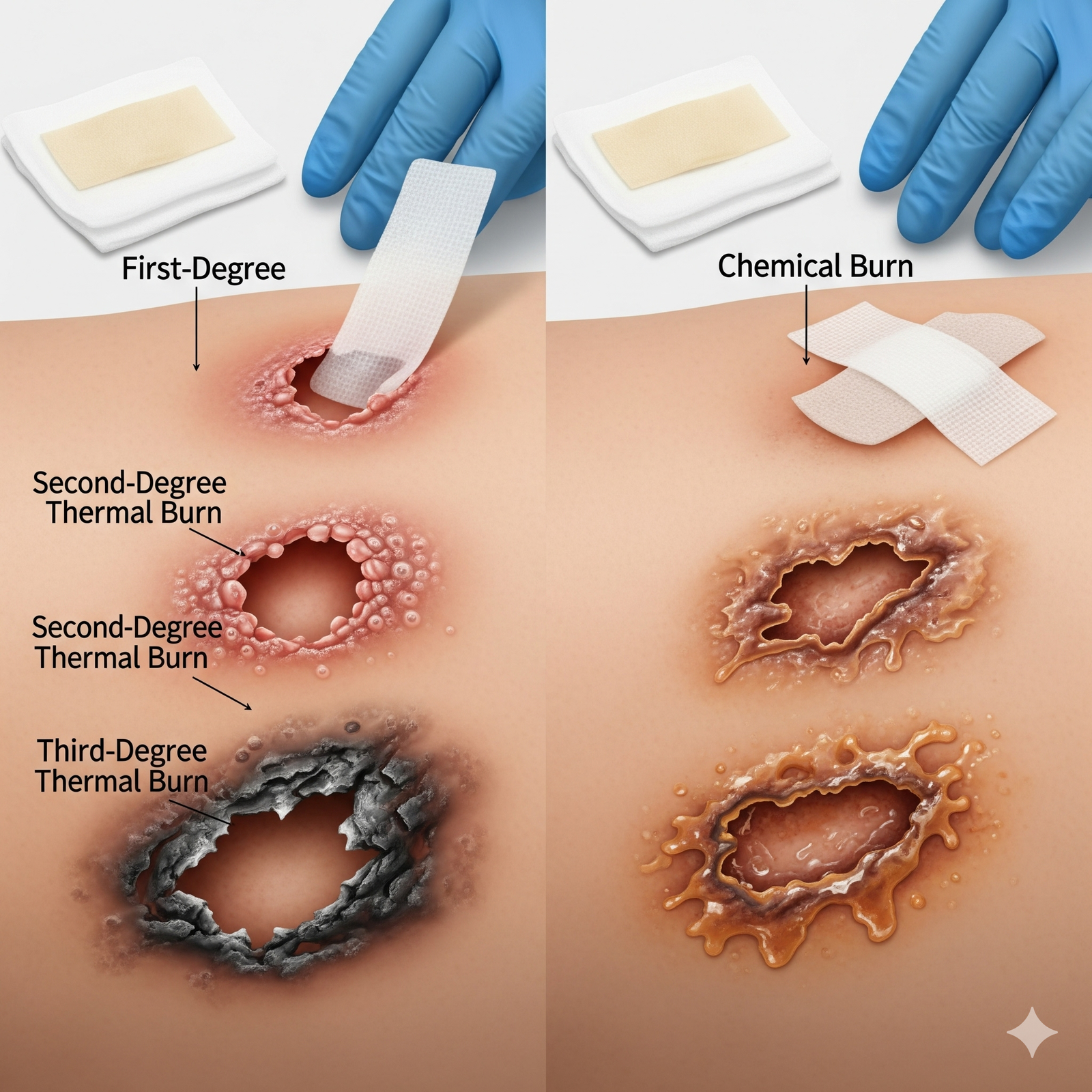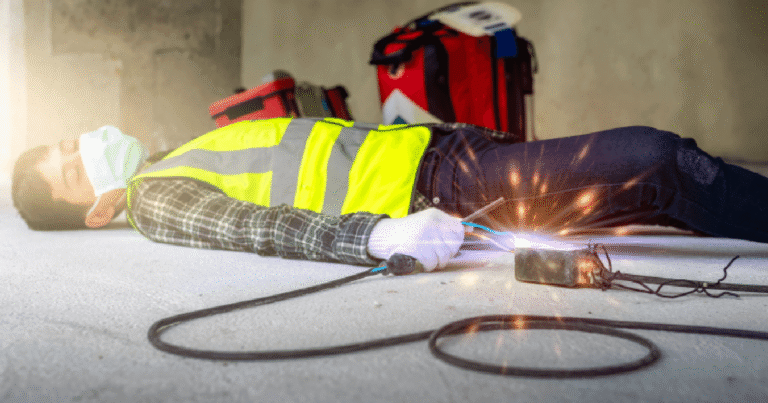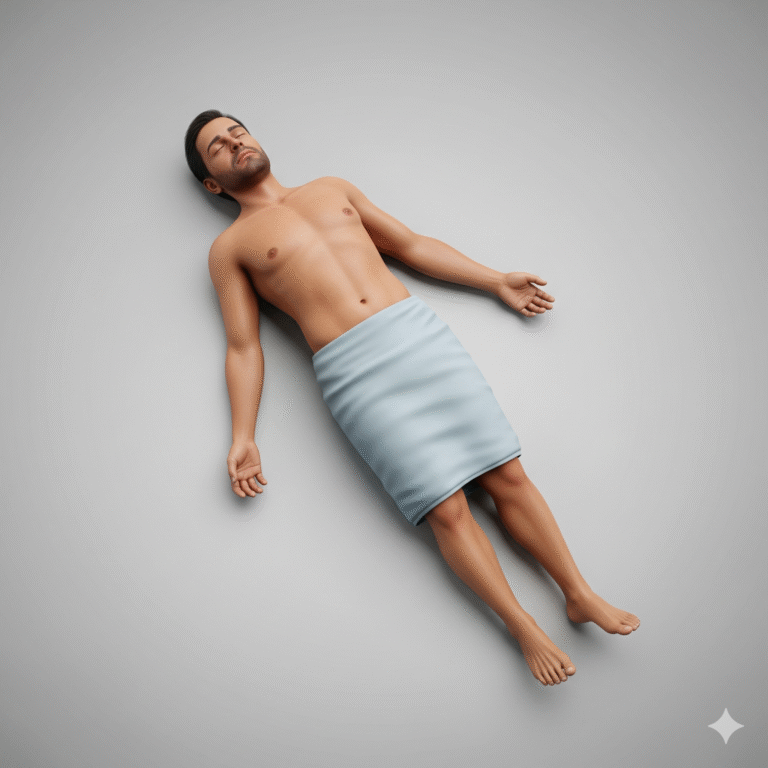Understanding Burns: Types, First Aid, Treatment & Prevention
Burns are injuries to body tissues caused by heat, chemicals, electricity, radiation, or friction. They range from minor to life-threatening and require different levels of care depending on their severity. Understanding how to identify, treat, and prevent burns is essential knowledge that can help minimize damage and potentially save lives in emergency situations.

Different types of burns: thermal (left), chemical (center), and electrical (right)
Types of Burns
Burns are classified by their cause and the depth of tissue damage. Understanding these classifications helps determine appropriate treatment approaches.
Thermal Burns
Thermal burns occur when heat damages skin tissue. Common causes include fire, hot liquids (scalds), steam, and contact with hot objects. These are the most common type of burns, especially in household settings.

Thermal burn showing characteristic redness and blistering
Chemical Burns
Chemical burns result from strong acids, alkalis, or other corrosive substances coming into contact with the skin or eyes. These burns can continue to damage tissue as long as the chemical remains in contact with the body and may require specialized treatment approaches.

Chemical burn showing characteristic tissue damage patterns
Burn Degrees: Understanding Severity
Burns are classified by depth of tissue damage, which helps determine appropriate treatment:
First-Degree (Superficial) Burns
These burns affect only the epidermis (outer layer of skin). Symptoms include redness, minor swelling, and pain. The burned area blanches (turns white) when touched. These typically heal within 3-5 days without scarring.
Second-Degree (Partial-Thickness) Burns
These burns damage both the epidermis and part of the dermis (second layer of skin). They cause redness, swelling, pain, and blistering. Healing takes 2-3 weeks and may result in some scarring, especially with deeper second-degree burns.
Third-Degree (Full-Thickness) Burns
These burns destroy all layers of skin and may damage underlying fat, muscle, or bone. The burned area appears white, charred, or leathery and may be numb due to nerve damage. These burns require medical attention and often skin grafting.

Cross-section showing how different burn degrees affect skin layers
Symptoms and Signs of Burns
Recognizing burn symptoms helps determine severity and appropriate treatment. Symptoms vary based on the burn’s depth and cause.
First-Degree Burn Symptoms
- Redness of the skin
- Minor swelling
- Pain and tenderness
- Skin that blanches when touched
- Dry, peeling skin as healing occurs
Second-Degree Burn Symptoms
- Intense pain and sensitivity
- Red, swollen skin
- Blisters that may break open
- Wet, shiny appearance
- Possible white or discolored patches
Third-Degree Burn Symptoms
- Leathery, waxy, or charred appearance
- White, brown, or black discoloration
- Lack of pain due to nerve damage (though surrounding areas may be painful)
- Dry, raised texture
- No blistering

Visual comparison: first-degree (left), second-degree (center), and third-degree burns (right)
Warning: If you experience any of these symptoms after a severe burn, seek immediate medical attention:
- Difficulty breathing or swallowing
- Burns covering a large body surface area
- Burns on the face, hands, feet, genitals, or major joints
- Deep burns affecting all skin layers
- Signs of infection (increased pain, redness, swelling, oozing)
- Burns caused by chemicals, electricity, or explosions
Immediate First Aid for Burns
Proper first aid can significantly reduce burn damage and improve healing outcomes. The approach varies based on the type and severity of the burn.
Emergency Burn Care
For severe burns, call emergency services immediately while beginning first aid.Call 911
First Aid for Thermal Burns
- Stop the burning process: Remove the person from the heat source and stop the burning process.
- Remove restrictive items: Take off jewelry, belts, and tight clothing before swelling begins.
- Cool the burn: Run cool (not cold) water over the burn for 10-15 minutes. Don’t use ice, as it can cause further damage.
- Cover the burn: Apply a clean, dry bandage or sterile gauze. Avoid using cotton that may stick to the burn.
- Manage pain: Take over-the-counter pain relievers like acetaminophen or ibuprofen as directed.

Cooling a thermal burn with cool running water for 10-15 minutes
First Aid for Chemical Burns
- Remove the chemical: Brush off dry chemicals, then flush with running water for at least 20 minutes.
- Remove contaminated clothing: Take off any clothing or jewelry that has the chemical on it.
- Cover the burn: Apply a clean, dry bandage or sterile gauze.
- Seek medical attention: Chemical burns often require professional evaluation.

Proper technique for flushing a chemical burn with water
Important: Do NOT apply the following to burns:
- Butter, oil, or ointments (for severe burns)
- Ice (can cause further tissue damage)
- Cotton balls or fluffy bandages (may stick to the wound)
- Adhesive bandages (may stick to the burn)
- Home remedies like toothpaste or egg whites
When to Seek Medical Attention for Burns
While minor burns can often be treated at home, more severe burns require professional medical care. Knowing when to seek help is crucial for proper healing and preventing complications.
Seek Immediate Medical Attention If:
- The burn is larger than 3 inches (about the size of your palm)
- The burn affects the face, hands, feet, genitals, buttocks, or a major joint
- The burn appears to be third-degree (white, charred, or leathery)
- The victim is an infant, child, or elderly person
- The burn was caused by chemicals, electricity, or an explosion
- There are signs of infection (increased pain, redness, swelling, oozing)
- The person shows signs of shock (pale skin, weakness, rapid pulse)
- There’s difficulty breathing or signs of smoke inhalation

Professional medical treatment for severe burns
Find Emergency Care Near You
Locate the nearest burn center or emergency department for specialized burn care.Find a Burn Center
Medical Treatments for Burns
Professional medical care for burns may include:
- Cleaning and debriding (removing dead tissue)
- Specialized dressings and bandages
- Intravenous fluids to prevent dehydration
- Pain management
- Antibiotics to prevent infection
- Skin grafting for severe burns
- Physical therapy to maintain function and prevent contractures
- Psychological support
Burn Prevention Tips
Most burns are preventable with proper safety measures. Implementing these precautions can significantly reduce the risk of burn injuries at home, work, and outdoors.
Kitchen Safety
- Keep children away from cooking areas
- Turn pot handles toward the back of the stove
- Use oven mitts when handling hot items
- Set your water heater temperature to 120°F (49°C)
- Never leave cooking food unattended
Fire Safety
- Install smoke detectors and check batteries regularly
- Keep fire extinguishers accessible
- Create and practice a fire escape plan
- Keep flammable items away from heat sources
- Never leave candles burning unattended
Chemical Safety
- Store chemicals in original containers
- Wear protective gloves and eyewear
- Follow manufacturer instructions
- Ensure proper ventilation when using chemicals
- Keep chemicals out of reach of children

Essential home safety equipment for burn prevention
Electrical Safety
- Inspect cords regularly for damage
- Avoid overloading outlets
- Use outlet covers in homes with young children
- Keep electrical appliances away from water
- Turn off and unplug appliances when not in use
Sun Protection
- Apply sunscreen with SPF 30 or higher
- Reapply sunscreen every two hours
- Wear protective clothing and hats
- Seek shade during peak sun hours (10 AM to 4 PM)
- Be extra cautious around water, snow, and sand, which reflect UV rays
Essential First Aid Products for Burns
Having the right supplies on hand can help you respond quickly and effectively to burn injuries. These essential products should be part of every home first aid kit.

Sterile Gauze
Non-stick sterile gauze is essential for covering burns without adhering to the wound. Look for individually wrapped pads in various sizes and rolls for larger areas.
- Non-adherent to prevent sticking to wounds
- Sterile packaging to prevent infection
- Various sizes for different burn areas

Burn Gel & Dressings
Specialized burn gels and dressings contain ingredients that cool, soothe, and protect burn wounds. They help relieve pain and create a protective barrier.
- Water-based gel for cooling relief
- May contain aloe vera or lidocaine
- Specialized dressings for different burn types

Medical Tape & Scissors
Secure dressings with paper or silk medical tape that’s gentle on sensitive skin. Bandage scissors help safely remove dressings without causing additional injury.
- Hypoallergenic tape for sensitive skin
- Paper tape for less adhesion
- Blunt-tip scissors for safe dressing removal
Complete Your First Aid Kit
Be prepared for emergencies with a comprehensive first aid kit that includes burn care supplies.Shop First Aid Kits
Understanding and Responding to Burns
Burns range from minor injuries that can be treated at home to severe, life-threatening emergencies requiring immediate medical attention. Understanding the different types and degrees of burns helps you respond appropriately and seek help when needed.
Remember these key points:
- Cool burns immediately with running water, not ice
- Never apply butter, oil, or home remedies to burns
- Seek medical attention for burns that are large, deep, or on sensitive areas
- Prevent burns through kitchen safety, fire prevention, and chemical handling precautions
- Keep a well-stocked first aid kit with burn-specific supplies

A well-stocked first aid kit should include specialized burn care supplies
Learn More About Burn Care
Download our free burn care guide for comprehensive information on burn prevention, first aid, and recovery.Download Free Guide




